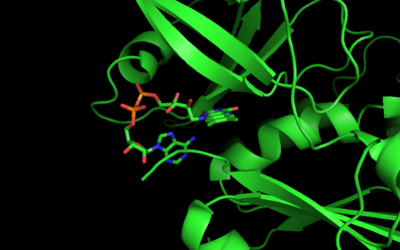Function
Ferredoxin NADP+ reductase [1] is an enzyme that catalyzes the reduction of NADP+ to NADPH. This enzyme belongs to a family of enzymes called oxidoreductases[2] that contain iron-sulfur proteins as electron donors and NAD+ or NADP+ as electron acceptors. FAD, [flavin adenine dinucleotide][3], is also a cofactor of FNR. The ferredoxin NADP+ reductase participates in a general reaction that proceeds as follows:
2 reduced ferredoxin + NADP+ ---> H+ + 2 oxidized ferredoxin + NADPH[4]
Anaerobic Function
In many facultatively anaerobic bacteria, FNR acts as an oxygen sensor modifying gene expression that adapts the cell to anaerobic growth. The activity of FNR regulates the cell's ability to metabolize aerobically or anaerobically so that when oxygen is abundant, FNR is destabilized and converted into an inactive form.[1] FNR is activated when there are low oxygen tensions (hypoxia). This function is known as transcriptional sensor-regulation.[2] The predominant pathway in which this regulation occurs is through binding or oxidation-reduction of oxygen in the iron sulfur center, in which the iron serves as the initiating cofactor that interacts with the oxygen when oxygen is abundant. This is a reversibly constitutive regulation pathway.[3]
Although facultative anaerobes prefer to use molecular oxygen as the terminal electron acceptor due the high reduction potential, low oxygen stress is able to induce the bacteria to use FNR instead. The transformation involves other proteins such as the sensor regulator system ArcAB, however these regulators are affected by other intermediates. FNR combines the functions of both a sensor and a regulator.
Other Functions
FNR is also an active protein in plants, and is found in the chloroplast and thylakoid membrane of the cell. The FNR reductive mechanism is responsible for the transfer of the final electrons during photosynthesis from photosystem I to NADPH, which then goes on to participate the Calvin cycle as a reducing cofactor.
In other organisms, FNR plays a role in metabolism such as oxidative stress response and steroid metabolism.[5]
Relevance
Observing the role of FNR in bacteria has the potential to be very important in the realm of pathogenic bacterial drug resistance. Understanding the mechanism and differences of the FNR function in organisms could be essential in the development of antimicrobial. Because the FNR mechanism and protein itself is slightly different in most living organisms, researchers are interested in learning how the FNR function can be inhibited specifically for harmful pathogens as this would likely not affect the host due to these differences and could be an antibiotic inhibition mechanism.[4]
Structural highlights
In its active form, the protein is a and contains a [4Fe-4S]+2 cluster. When inactive, the protein is monomeric and containts a [3Fe-4S]+2 cluster. FNR in its form can be seen here, with bound NADP and FAD.[5]
3D Structures of Ferredoxin NADP+ reductase
Ferredoxin NADP+ Reductase 3D structures

